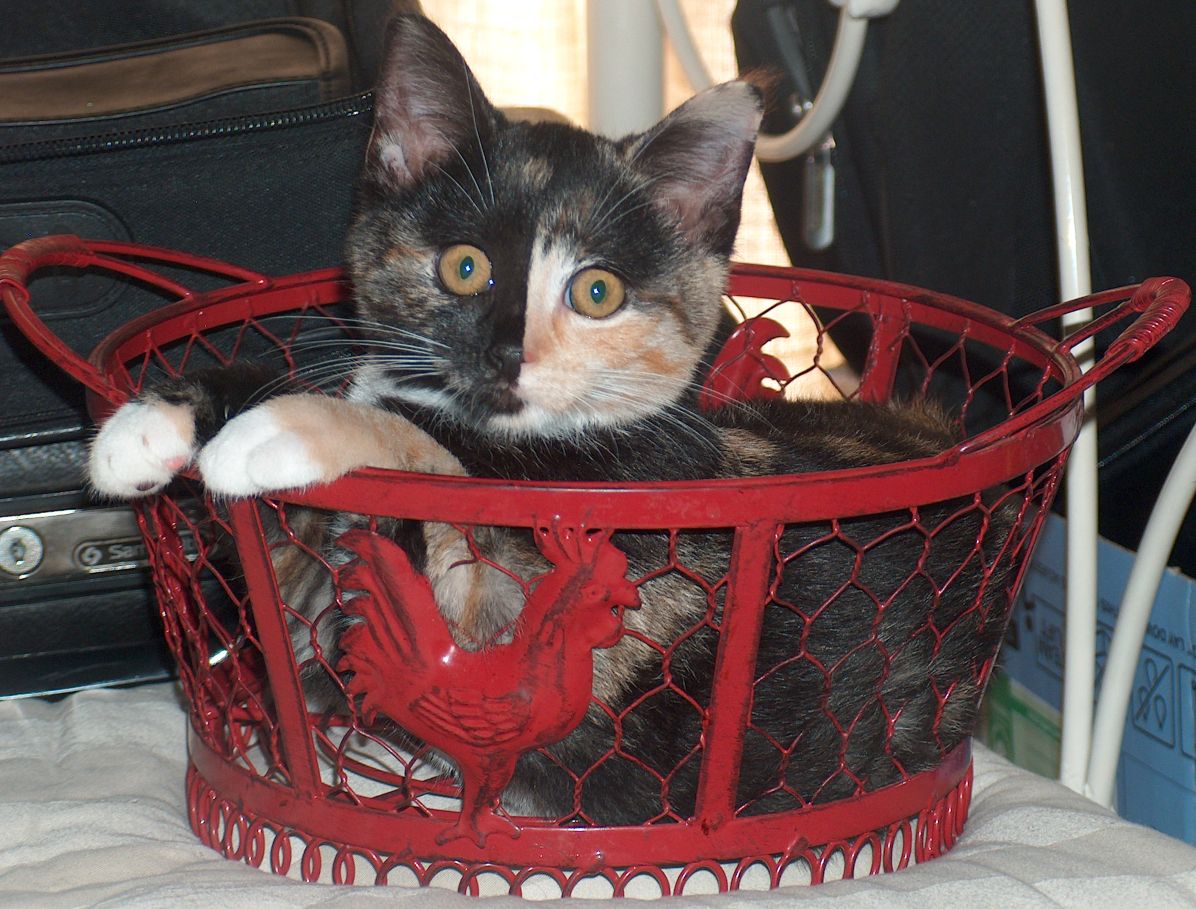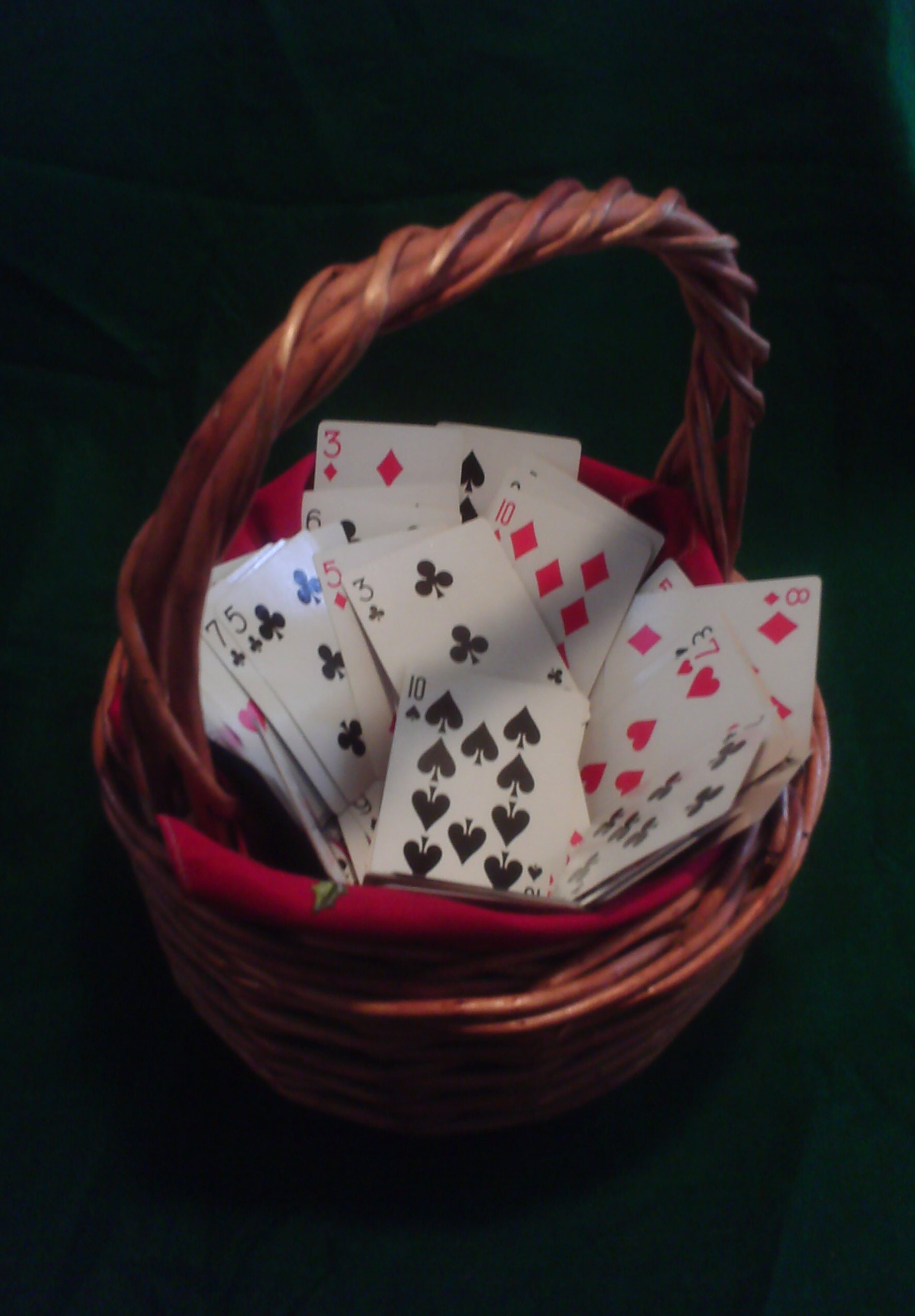
Canasta, originating as a Latin American game quickly spread to the United States and much of the rest of the world. It was the most popular of all card games in the United States in the early 1950's and is still popular in many parts of the world today.
This rummy type game which is named for the Spanish word for basket, is also the name for one the special melds required in the game.
The basic game of Canasta is played with two standard 52 card decks plus four jokers, making a total of 108 cards.
The game is played by four players in two partnerships in which each partnership plays against the other partnership. The players should seat themselves at the table such that each player sits directly across from his partner. In this way, in the play of the hand, the players of a partnership will alternate players.
If the partnerships are not set in some predetermined manner, each player should draw from the shuffled, face down deck. Whichever player draws the highest card is the first to play a card in the first deal. This player may also determine his seating position at the table. His partner will be the player who is dealt the second highest card. This player will sit directly across from his partner at the table. The other two players (drawing the lowest two cards) will play as partners against these players.
The dealer will be the player who ends up sitting to the right of the player who drew the highest card. After each hand, the turn to deal will rotate around the table in a clockwise direction from player to player. When drawing cards, for determination of who has the highest card (and so on) the cards rank as follows (Ace, King, Queen, Jack, 10, 9, 8, 7, 6, 5, 4, 3, 2). The suits, for purpose of this draw rank as follows (from highest to lowest):
spades (♠), hearts (
♥), diamonds (
♦) and clubs (♣). If two cards of the same rank and suit are drawn, the first one drawn is considered the higher card. If any player draws a joker, he must draw another card as the jokers are not considered to have a value when drawing for partnerships.
All 108 cards should be shuffled together by the dealer and then cut by the player to the dealers immediate left (which, as per the draw above, will also be the first player to play in this hand). The dealer begins by dealing one face-down card to each player, starting at the player to his left. The dealer continues distributing the cards, in a clockwise direction until each player has 11 cards. Once the initial hands are dealt, the dealer then places the remainder of the deck in the center of the table face down as a stock pile. He then turns over the top card of the stock pile and places it face up beside the stock. This is the upcard, which forms the beginning of the discard pile. If this first upcard is a joker, trey (3) or deuce (2), he must turn another card from the stock and place it atop this card. He must continue to do this until the card is any card but a joker, trey or deuce.
In the game of Canasta there are several cards that have special significance:
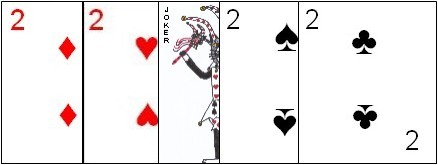 All jokers and twos (deuces) are wild cards, and can thus be melded (see below) with other, natural cards at which point the wild card takes on the rank of the natural cards used in the meld. Wild cards must always be melded with natural cards, in other words a meld of just wild cards is never allowed. For scoring of the meld, however, the wild cards earn a score of 50 or 20, as per the chart below.
All jokers and twos (deuces) are wild cards, and can thus be melded (see below) with other, natural cards at which point the wild card takes on the rank of the natural cards used in the meld. Wild cards must always be melded with natural cards, in other words a meld of just wild cards is never allowed. For scoring of the meld, however, the wild cards earn a score of 50 or 20, as per the chart below.
- Red threes (threes in the suit of hearts or diamonds) can never be melded per se, however, at the end of the hand, they may entitle the holder to bonus points.
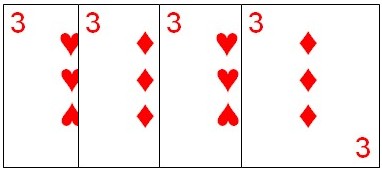 If a player is dealt a red three as part of his initial hand, at his first turn, he immediately lays it face up in front of himself and draws a replacement card from the stock. If anytime during the play of his hand, he draws a red three from the stock, he also lays it face up in front of himself also drawing a replacement from the stock. If he obtains a red three from taking the discard pile, however, he still lays it face-up in front of himself, but does not draw a replacement card. At the end of the hand, these red threes can produce significant bonus points for the holder (although, in some cases they can also incur a penalty, as explained in the scoring section below).
If a player is dealt a red three as part of his initial hand, at his first turn, he immediately lays it face up in front of himself and draws a replacement card from the stock. If anytime during the play of his hand, he draws a red three from the stock, he also lays it face up in front of himself also drawing a replacement from the stock. If he obtains a red three from taking the discard pile, however, he still lays it face-up in front of himself, but does not draw a replacement card. At the end of the hand, these red threes can produce significant bonus points for the holder (although, in some cases they can also incur a penalty, as explained in the scoring section below).
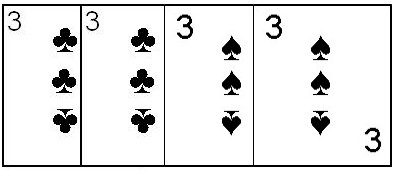
- Black threes (threes in the suits of spades or clubs) are considered natural cards (see below), however they can never be melded with any wild cards and can only be laid down as a meld when going out (laying down the last of your cards to end the hand).
Wild cards as well as the black threes are considered "stop" cards on the discard pile, which affect the circumstances in which the draw pile may be picked up.
The remaining cards (A,K,Q,J,10,9,8,7,6,5,4) are considered natural cards and will be used throughout the game to make various point scoring melds.
Play of the Hand
The basic object of Canasta is to form melds for the purpose of scoring points. Melds consist of three or more equally ranked cards. Unlike in other rummy type games, in Canasta only cards of equal ranks (with possible wild cards) can be melded. Sequence melds can never be made. Wild cards can also be used in the melds, however they have a few stipulations: Any
particular meld can never have more than three wild cards and all melds must contain at least two natural cards.
The scoring values of a meld is dependent on the rank of the cards which make up the meld. Each card in the meld scores for itself, as follows:
| Card Rank | Score per card of this rank in the meld |
|---|
| 7, 6, 5, 4 | 5 |
| Black 3 (♠,♣) | 5 |
| King, Queen, Jack | 10 |
| 10, 9, 8 | 10 |
| Ace, 2 | 20 |
| Joker | 50 |
|
|
|
The score for a particular meld is based on the additive score for each individual card within the meld, thus,
as an example, a meld of four 9's and two jokers would score a total of 140 points (10
point for each nine and 50 for each Joker). A partnership may not meld more than one group of a specific rank, however the additional cards of that rank would simply be added to the existing meld previously made by that partnership.
Before a partnership can play their first meld of each hand, this first meld must meet a specific score criteria. This initial meld (as well as subsequent melds) can consist of multiple individual groupings of cards. Once one member of the partnership makes this initial meld, any legal melds of any value can then be played on the table by either member of the partnership on his turn. Multiple card groupings can be used to total this amount for the first meld, and once one member of a partnership has made this meld, both partners in the partnership are free to meld normally for the remainder of the hand. The total necessary for this initial meld is
dependent on the partnerships current listed score at the time when they are about to play the meld, as per the following chart:
| Partnership's Current Score | First Meld Minimum Score Requirement |
|---|
| Under 0 (minus score) | 15 |
| 0 to 1499 | 50 |
| 1500 to 2999 | 90 |
| 3000 and Over | 120 |
Once this initial meld is laid, that side can then meld any valid melds as well as have more leeway in taking the discard pile (see "Taking the Discard").
The total meld score required for a sides initial meld can only come from raw meld card scores (see chart above) and any bonus points for special melds (such as the bonus points scored at the end of the end for each canasta) may not be used for consideration of this minimum necessary score.
Each players turn consists of first drawing the top card of the draw pile or taking the entire discard pile. There are certain restrictions and rules regarding the taking of the discard pile (detailed below in the Discard Pile section).
After drawing, the player may then play any legal, allowable melds or play additional cards onto melds his partnership has already made. At the end of his turn, he must then discard one card to the discard pile. If a player plays all his cards in going out, he need not discard a card that turn (but a player can also go out with their normal discard at the end of their hand).
Canastas
A canasta, the game's namesake, is a meld of 7 cards of the same rank. There are two types of Canastas, a natural canasta and a mixed canasta.
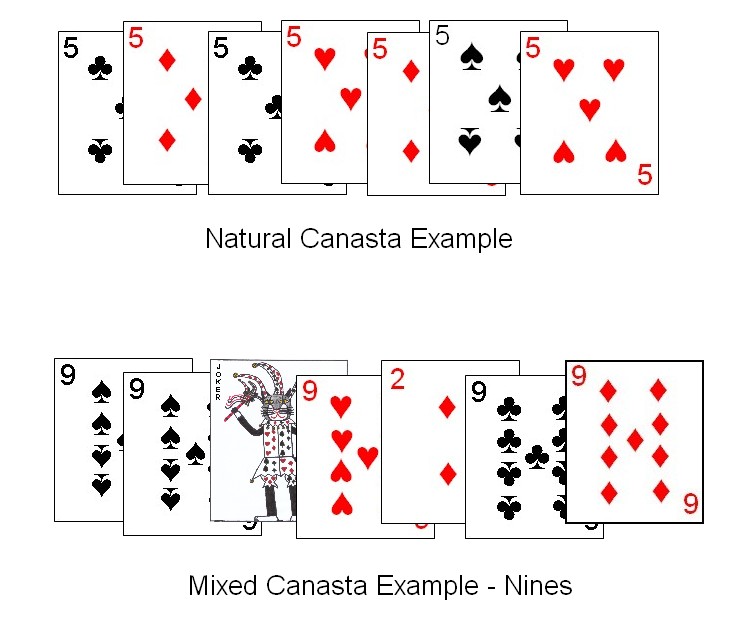
A natural canasta (sometimes called a pure canasta) is when there are no wild cards in the Canasta, thus all seven cards are of the exact same rank. A mixed canasta is when the meld contains one or more wild cards.
After a canasta is first melded, additional cards may be added to the meld. However, if any wild cards (never more than three) are added to an existing canasta that canasta then becomes a mixed canasta (which reduces its bonus score added at the end of the hand).
In addition, a partnership MUST meld at least one canasta (either natural or mixed) before it can go out. Until the partnership has melded a canasta, both players must retain at least one card in their hand. The bonus score, awarded at the end of the hand, is 500 for each natural canasta melded and 300 for each mixed canasta.
After a complete canasta is melded, it's card are usually piled together. To help distinguish mixed and natural canastas apart, by convention a red card is placed on the top of a natural canasta and a black card being the top card of a mixed canasta.
The Discard Pile
Taking the discard pile when it contains a large number of cards may often allow a partnership to gain a scoring advantage in the hand, thus there are various restrictions on when this discard pile can be taken.
- The discard pile may NEVER be taken by any player when the top card is a wild card (joker or deuce) or black three (three of clubs or spades).
- Before a side has made its initial meld of the hand, the discard pile is "frozen" for that side. When the discard pile is frozen to a partnership, they may only take the discard pile if they hold two identical natural cards that match the top card of the discard pile. Before taking the pile, the player must show the two cards after which he must immediately meld them with the top card. If the players side has not yet met the initial meld requirement for this hand, they must also show (and then subsequently meld) all such cards before taking the pile. Thus, only the top card of the discard pile can be used to meet the initial meld scoring criteria. However, the player can meld any additional cards found in the discard pile after showing the required meld and playing the meld.
- The discard pile is also frozen to both sides (with the same restrictions as above) as long as it contains, anywhere, a red three or wild card. Generally the bottom card of the discard pile is turned crosswise to indicate that it contains one of these cards and is frozen.
- Under all other circumstances the discard pile is not considered frozen and can be taken by a player in their proper turn in any of the following circumstances:
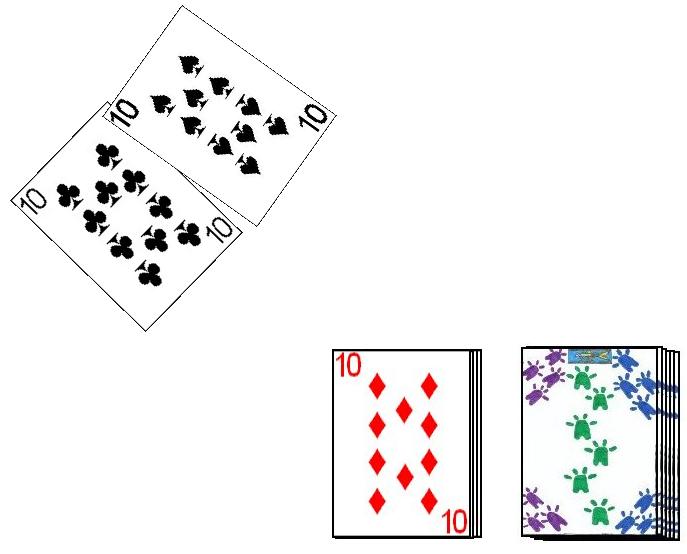
- As above, when the pile is frozen, a player can take the discard pile if they have two cards of identical rank to the top card of the pile. They must show the cards before taking the pile and placing the meld.
- If the player has one card of matching rank to the top discard and one wild card, they may take the discard pile. These cards must be displayed before taking the pile and then must be melded to the table.
- The top card of the discard pile can be laid off on a meld already laid down by their partnership.
When a player takes the top card of the discard pile in any circumstance, they must take the entire discard pile into their hand. After showing any required cards and making required melds, the player can play additional melds using cards from their hand and the discard pile.
Going Out
When a player plays all his cards in melds or discards his last card he is said to have gone out. A player may not do this if his partnership has not yet melded a canasta. However, a player could play this necessary canasta as part of going out.
When any player goes out, the hand immediately ends and scores are tallied.
If a player goes out and this player has not yet, before this turn, played any melds to the table, he is said to have gone out concealed. This is worth bonus points at the end of the hand (see below).
Before going out, a player may ask his partner "permission" to go out. This is not required, however if the player does ask, he must abide by the decision made by his partner. In addition, a player who has asked and received a confirmative answer, must go out on his next turn. A player may not ask permission to go out if he has already melded that turn.
If the last card of the stock pile is taken, play continues as long as each subsequent player takes the discard. During this stage of the game, the rules for taking the discard are somewhat different. At this time, a player, on his turn, must take the discard if it matches any of that players partnerships melds on the table and the pile is not frozen to that partnership. A player may (but is not required to) take the card for forming a new meld. The hand ends when a player cannot or chooses not to take the discard pile (when it is optional). If the last card drawn from the stock is a red three, however, the player plays it on the table (garnering his normal bonus points) and play immediately ends. When play ends in this fashion, the scoring occurs as normal with each player subtracting from their partnerships score all card values remaining in their hand.
Scoring
Once a player goes out (or the stock is exhausted and no player takes the discard, as per the rules above), all the remaining cards in each other players hand (including the partner of the player who played their last card) is subtracted from that partnerships total score.
The point values for these cards remaining in the players hand is the same as the scores used for their values when melding (see chart above). Any card remaining in a player hand at this stage of the game are penalized in this way, even if the cards could be subsequently melded. In addition to the scores the partnerships get for scoring their individual melds, the following bonus points are also scored at this time:
| Scoring Condition | Bonus Score |
|---|
| For going out | 100 |
| Going out concealed (additional) | 100 |
| Playing Red Three | 100 |
| (Or) A Partnership playing all 4 red threes | 800 |
| Natural Canasta (each) | 500 |
| Mixed Canasta (each) | 300 |
Note regarding Red Threes: If a side has not made any melds during a hand, instead of a positive value, they instead must subtract 100 points from their score for each such red three they possess (or 800 if they have all four) during that hand. If, for any reason, a player contains a red three in their hand that they did not place on the table during the hand, this subtracts 200 points from their partnerships score for each such red three found in the hand. If a partnership plays all four red threes to the table, they obtain an 800 point total bonus instead of just 100 for each.
The first partnership to reach 5,000 points at the end of a hand wins the game. If, at the end of a hand, both partnerships reach or exceed this total, the partnership with the higher total wins the game. The winner is usually said to have won the game by the difference between their score and their opponents.
Below are several common variations of Canasta as well as versions of the game for differing numbers of participants.
Two Hand Canasta: This version, for two players is played identically to the standard game, with the following differences:
- Each player receives 15 cards in each hand.
- A player must play two canastas (natural or mixed) before they can go out.
- When a player draws from the stock pile, they draw two cards, but discard only one.
In all other respects the game is played the same as the rules for standard game described above.
Three Hand Canasta: Three hand is also very similar to the standard rules of Canasta. At the start of the game, each player plays for himself, however the first player to take the discard pile then plays against the other two players who play as temporary partners for that hand.
The players are initially dealt 13 cards to their hand. As in two hand canasta when a player draws from the stock pile, they draw two cards but only discard one on each turn. When scoring, each partner individually gets the full score that the partnership gained while the opposing player obtains whatever score he tallied during the hand. The first player to obtain 7,500 or more points wins the hand. If more than one player reaches or exceeds this total, the player with the highest total wins the game.
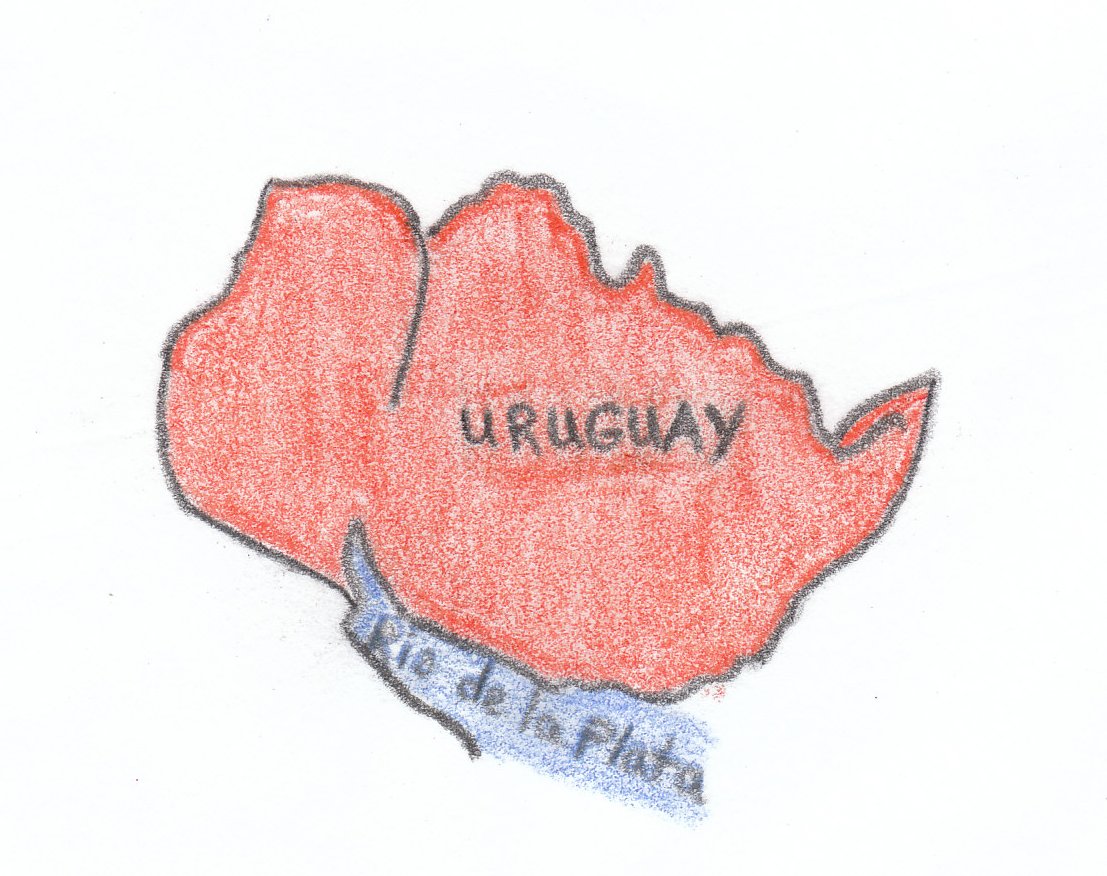 Uruguay
Uruguay: This version is played identically to the standard game of Canasta with the following changes to the basic rules:
- In regular Canasta wild cards can only be melded with other, natural cards. However, in the game of Uruguay, a group of three or more wild cards (maximum of seven) are considered a valid meld. A meld of such wild cards can contain any combination of wild cards but should not contain any natural cards. If a canasta of wild cards is made, this scores 2,000 points for the partnership playing the meld.
- In Uruguay, the discard pile is always frozen. Thus, the discard pile can only be taken by a player matching the top card of the discard pile with a pair of natural cards held in the hand. As in standard Canasta the discard pile may never be taken when the top card is a red three or any wild card.
In all other aspects, the rules for Uruguay are the same as for the standard rules given above.
 Mexicana
Mexicana: This game, also sometimes called Mexican Canasta, follows the rules for the standard game of Canasta with the following differences:
- The deck consists of three standard packs all shuffled together, along with six jokers, for a total of 162 cards in the deal.
- When dealing, each player receives a hand of 13 cards.
- When a player makes the first, initial meld for his side on the deal, he draws the top 13 cards from the stock pile, adding them to his hand. If, for any reason there are less than 13 cards remaining in the stock, the player takes all that are left. Play continues as in the standard game when the stock is exhausted.
- A Canasta of sevens counts 1,000 points. This can be either a mixed or natural canasta.
- The discard pile may not be taken if it's top card is a seven.
- In order for a side to go out it must meld at least two canastas. In addition, the side must meld a number of red threes equal or greater to the total number of canastas they have melded in the hand.
Samba: Like Canasta, Samba had a huge surge in popularity and was a very popular game in the Americas (and other countries as well). There are several significant changes in Samba that differ from the parent game of Canasta.
The game of Samba uses three standard 52 card decks along with six jokers (a total of 162 cards). Like the parent game it is generally played by four players, in two partnerships.
The selection of the dealer, ranking of cards, partners and the deal of the cards is the same as basic Canasta, however each player receives 15 cards.
When a player draws from the stock pile, they draw two cards each turn and discard just one.
The major change in Samba is that sequence melds can be made. Certain rules, however, govern these melds:
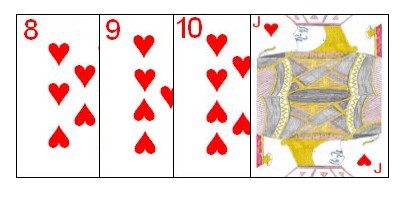 Sequence Melds
Sequence Melds:
As in standard Canasta, players can meld groups of cards of the same rank (with any appropriate wild cards), but, in this game sequences can also be melded. A sequence consists of three or more cards, of the same suit that are numerically in sequence (such as 8,9 and 10 of spades). The Ace is considered high and thus comes after the king.
Wild cards cannot be used in a sequence meld under any circumstances. Only cards from a players hand may be used in playing a sequence meld, so they can never draw the top card of the discard pile to play such a meld. However, when finding cards that form a sequence meld when drawing the additional contents of the discard pile they may play them as normal. A sequence of seven suited cards is called a Samba and scores a bonus of 1,500. It counts as a canasta for purposes of the requirement of playing one canasta before going out.
Other differences: In addition to sequence melds, there are a few other differences between canasta as well. A partnership may have as many melds of the same rank or suited sequence as they want, and, like the sequence melds, may combine these as appropriate, even creating a canasta or Samba if it meets the necessary card requirements. If the discard pile is not frozen for a side, they may, however, take the discard pile, to add its top card to an appropriate meld (group or sequence) they have already played on the table. If the discard pile is frozen to a side (or both ), they can only take the pile when they contain a natural pair that matches its top card or if the top card of the discard pile would allow extension of an existing meld by three cards. As in the standard game, they must show these cards before taking the card (and rest of the pile) and playing the meld. If the pile is not frozen, it may be taken to match with two natural cards in the hand (as when frozen) or if the top card can be added to a meld the partnership already has played to the table. A player may not end the game by going out (playing or discarding their last card) unless their side has played two canastas (these can be any combination of mixed and natural canastas and sambas).
There are also several differences regarding the scoring in Samba:
- There is no extra bonus for going out with a concealed hand.
- The bonus for going out is 200 points instead of the 100 in standard canasta.
- Red treys are worth 100 each, however a side obtaining all six gets a bonus of 1000 points. As in the standard game, a side must have played at least one meld to the table in order to obtain this bonus. Otherwise the score for the red threes is subtracted from the partnerships score.
- The game is won by the first side to reach or exceed 10,000. In the event of both sides obtaining this score on the same hand, the side with the higher score is declared the winner.
The first meld score requirements are similar to the standard game (although the range is somewhat higher). The following table shows these requirements in Samba:
| Partnerships Score | First Meld Score Requirement |
|---|
| Under 0 (minus score) | 15 |
| 0 to 1499 | 50 |
| 1500 to 2999 | 90 |
| 3000 to 6999 | 120 |
| 7000 and Above | 150 |
 Chile
Chile: This game is similar to Samba, above. The following are the only differences:
- Only one Canasta is required by a partnership before a player from that partnership may go out.
- Chile canasta allows either sequence melds (as in Samba) or wild card melds (as in the rules for Uruguay), but not both in the same hand. It must be decided by the players which of these additional melds they are going to allow. In all version of the game, the standard ranked melds are allowed.
- Each player is dealt 11 cards, one at a time, to start the game.
- When drawing from the stock, only one card is drawn and one card is discarded (except, on their last play of the hand, a player need not discard if playing all his cards to melds).
 Bolivia
Bolivia: This game is another variant that is played similarly to Samba. Sequence melds are allowed as well as a meld of only wild cards. A meld of wild cards can be any combination of jokers or deuces (minimum of 3 such cards in the meld as normal). A canasta of 7 wild cards is called a Bolivia and is worth 2,500 bonus points at the end of the hand. Sequence melds are allowable in this game, just as in Samba and are called an Escalera. As in most variations of Canasta the discard pile cannot be taken if its top card is a wild card or black three. The initial meld requirements in Bolivia are exactly the same as given for Samba. To win the game a partnership needs 15,000 points or more.
Before a player can go out, his partnership must have melded two Canastas. One of the these canastas must be an Escalera (sequence Canasta) but the other can be any type of legal Canasta. When any player goes out, black threes left in a hand subtract 100 points from that partnership's total score. When melded (which can only be done upon going out) black threes are worth their standard 5 points each. Red threes have the standard scores and penalties associated to them as in Samba.
 Cuban Canasta
Cuban Canasta: This game is another direct variation of the parent game Canasta. In this game, two standard decks are used along with four jokers. Each player is dealt 13 cards. Each player draws one card on each turn and discards one at the end of the turn. If the player is going out, they need not discard if they are using all their cards in melds on the turn.
In this version of the game, the discard is always considered frozen to both partnerships. Thus the top card (and thence the entire pile) can only be taken by a player who shows and then melds a pair of natural cards that match the top card of the discard pile.
Any canasta may never contain more than 7 cards. Before a player in a partnership can go out, their side must have played at least one canasta. The first meld score requirements for Cuban Canasta are given in the following table:
| Partnerships Score | First Meld Score Requirement |
|---|
| Under 0 (minus score) | 15 |
| 0 to 1499 | 50 |
| 1500 to 2999 | 90 |
| 3000 to 4999 | 120 |
| 5000 and Above | 150 |
Red threes gain the following bonus points for the partnership receiving them:
- 100 for 1
- 300 for 2
- 500 for 3
- 1000 for all (4 total)
If a side has not melded a legal canasta these points are subtracted from their score.
In this version a black three may never be discarded on any players first turn. If a player, when taking the pack finds any black threes in it, they are removed from play and earn the side 5 points each. If a partnership gains all 4 black threes in this way or melds them the side earns 100 points total instead.
A meld of just wild cards is allowed in this game, and have the following values:
- Seven 2's gain 4000
- Four jokers and three deuces get 3,000
- Any other combination of seven wild cards (deuces and jokers) gains 2,000
Sequence melds are not allowed in Cuban Canasta. If the top card of the discard is a wild card (or a black three) it may never be taken. Going out receives a 100 point bonus for the side which does so.
Brazilian Canasta: This game is similar to the Canasta variation Bolivia. The main differences are in the initial meld score requirements and the scoring received for the various canastas.
The requirements in Brazilian Canasta for the initial meld are as described in the following table:
| Partnerships Score | First Meld Requirement |
|---|
| Under 0 (minus score) | Melds totaling at least 15 points |
| 0 to 1499 | Melds totaling at least 50 points |
| 1500 to 2999 | Melds totaling at least 90 points |
| 3000 to 4999 | Melds totaling at least 120 points |
| 5000 to 6999 | Melds totaling at least 150 points |
| 7000 to 7999 | Any valid Canasta |
| 8000 to 8999 | Melds totaling at least 200 points |
| 9000 or higher | Any natural Canasta |
|
|
|
|
 |
In some of the higher score brackets of this game the initial meld requirement may include a Canasta. Thus, for the 7,000 to 8,000 point range it can be any Canasta mixed or natural. For the 9,000 and higher bracket the hands initial meld must contain at least one natural canasta.
As in Samba, in this game a meld may be made of only wild cards and a Canasta consisting of only wild cards is worth 2,000 points. Sequence melds and Canastas are also allowed in Brazilian Canasta. However, when each hand ends, any side that has a sequence meld on the table of four cards or less must subtract 1,000 points from their score.
In Bolivian Canasta the values for played red threes is positive if a partnership has melded at least one Canasta but the points are instead subtracted from the partnerships if they have not melded a Canasta in the hand. The values for the red threes are as follows: 100 each for having up to 5 such cards, having exactly 5 counts 1,000 and having six counts 1,200.
When going out, a player may add cards to the ends of their sides previously played sequence Canastas.
The discard pile may never be taken for part of a partnerships initial meld.
When a player is to go out, they MUST ask their partnership for permission before doing so and must abide by the response of their partner.
The first partnership to reach 10,000 points or more at the conclusion of a hand is declared the winner of the game. However, if both partnerships reach this total, the partnership with the higher total wins the game.
Italian Canasta: This is another game which follows closely the rules of Samba. The rules for Italian Canasta are the same as that for Samba, with the following exceptions:
When the players are first dealt all their cards they should immediately replace their red threes before the top card is turned over to start the stock pile. When this top card is flipped, a number of additional cards, equal to the top cards rank are removed from the top of the stock and added to the discard pile. These cards are placed face down and the original card is placed on top of this stack. Thus, if a 5 was the initial card flipped over to start the discard pile, five additional cards would be taken from the stock pile, placed face down and the original 5 would be placed on top. For purposes of determining the ranking of special cards, Aces and Jokers require 20 cards, a King requires 13 cards, a queen requires 12 and a jack requires 11 such cards. These cards are part of the discard pile and are taken by the first player who legally takes the pile.
In Italian Canasta the discard pile is always considered frozen (Thus the top card, and the rest of the discard pile, may only be taken by a player with a natural pair in his hand).
The initial meld requirements for a side are as per the following table:

| Partnerships Score | First Meld Requirement Value |
|---|
| Under 0 (minus score) | Any valid meld |
| 0 to 1499 | 50 |
| 1500 to 2999 | 90 |
| 3000 to 4999 | 120 |
| 5000 to 7499 | 160 |
| 7500 to 9999 | 180 |
| 10,000 or higher | 200 |
As in other forms of Canasta, wild cards (Jokers and deuces) may be used as part of the initial meld, however their score may not be added for purposes of determining if the meld meets the minimum meld score requirement for the hand.
Canastas consisting of nothing but wild cards are allowed in this game, however a Canasta of wild cards does not count towards the required play of two Canastas by a side before they can go out.
Although considered wild cards, a meld of deuces can be made in this game. In this regard the meld is considered a standard (non wild card) meld. This meld may contain a maximum of three jokers. A Canasta of deuces is similar to a standard Canasta. If it contains one to three Jokers it is a mixed deuce canasta, scoring 2,000 points, and if it contains no jokers it is a natural deuce canasta and scores 3,000. Only the side going out may obtain these bonus scores for such melds, while the other side will obtain the normal card rank points for the cards in the canasta. If a partnership has a legal meld of deuces in this manner, they cannot meld any deuces as wild cards in any other melds until they complete a canasta of deuces. A legal Canasta of deuces can also be counted towards the required two canastas needed for a partnership to go out.
The red three scoring is also slightly different in this version: From one to three red threes they are worth 100 each. If a partnership has 4 or more, however, they score 200 each. This is a bonus score if the side has made at least one meld, but the amount is subtracted from their score if they have neglected to make a meld on that hand.
If a partnership manages to play five natural canastas in a hand they score a bonus of 2,000 points. For five canastas which includes a mixed canasta the side scores 1,000. If a side plays ten canastas (any combination of mixed or natural) they score 2,000. The first partnership to reach 12,000 wins the game.
British Canasta: This is another variant of the base game, however which is often played in the United Kingdom. It is played identically to standard Canasta with just one difference. In British Canasta, a player on his turn, may loudly and clearly state "Acaba" (translated to "The End"). This declaration, by any player immediately ends the hand, with the team making the declaration scoring 0 points for the hand, and the opposing team scoring 1500 points. A player may, but is not required to, ask for his partner's permission to declare "Acaba" before making the declaration, but if he does so ask for this permission, he must abide by the response from his partner.
Canasta Americana: Canasta Americana, also known as American Canasta or Modern American Canasta is another Canasta variant that developed out of the great Canasta craze the swept the United States during the 50's and 60's. Like most other variants of Canasta, Canasta Americana is designed for play by four in two partnerships of two players each. The game is played using two standard 52 card decks shuffled together and four total Jokers added to this double pack. All twos and Jokers are considered wild cards in this game and can be used to replace a card of another rank in melds.
Determination of partnerships, seating positions and the first dealer can all be performed as in standard Canasta. Each player should sit directly across the table from his designated partner for the game.
After the cards are shuffled and cut, the dealer begins dealing the cards to the players in a clockwise rotation around the table. He continues dealing until each player has a total of 13 cards. In addition, the ninth card from the bottom of the deck is turned at a 90 degree angle from the rest of the deck, still being kept face-down in the deck. This card is called the turn card, and a player who draws this card during play of the hand must clearly announce this to the other players, signifying that the game will end soon. In this game the top card of the deck is not placed beside the draw pile as in some other versions and thus the first player may only draw the top card from the stock on his first turn.
The player to the immediate left of the dealer has the first turn and the turns rotate in a clockwise direction. Each turn consists of first a draw, optional melding (if able), and finally a discard ending the turn. A player may always, on his turn, draw the top card from the stock. He may also take the entire discard pile into his hand, as his draw in certain circumstances (and if he chooses to). In order to do this the player must have two
natural (non-wild cards) in his hand which are of the same rank as the top card of the discard pile. These cards must be immediately melded to the table by the player (either creating a new meld or adding a meld, by that team, of the denomination, but never forming a meld of more than seven cards). The player may also not take these cards if his team has not yet made his first meld of the game, although the initial meld using these cards may be used to help fulfill this requirement, as long as the appropriate score in melded cards is made on that turn by the player, not including the cards take from the discard pile.
After a player draws, he may then make any melds to the table as able. A meld is three or more cards of the exact same rank. It may also contain wild cards, but must always contain more natural cards than wild cards and, in any event, can never contain more than two wild cards (except a wild card meld, explained further below). All melds by a specific partnership, and that team may only have one meld of each specific rank during the game. No meld may ever contain more than seven cards.
All threes in this game (both black threes and red threes) are special cards and, if found in the initial hand or drawn from the deck, should be placed face-up on the table in the melding area for that team. These cards will usually be worth bonus points at the end of the hand. Any time a player places these cards on the table, he should immediately replace those cards with an equal number of cards from the stock. There is one exception to the requirement for playing a three found in the hand to the table. If a player's partnership has not yet played it's initial meld, a player may retain, at most, one three in his hand, in order to try to form the special hand, "straight". Once a team plays it's initial meld however, the three must be played to the table as normal.
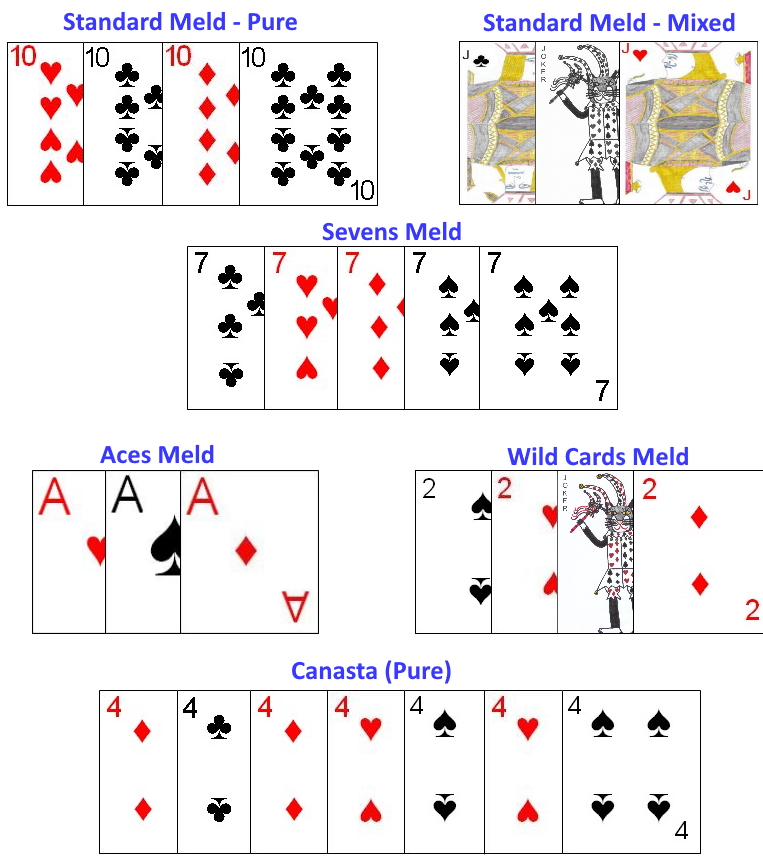
The game consists of a number of meld types, as follows:
- Standard Meld: This is a meld of three to seven cards, all of the same exact rank. The allowable ranks which can be melded in this way are fours, fives, sixes, eights, nines, tens, Jacks, Queens, and Kings. This meld may also contain wild cards. Such a meld that contains all natural cards (no wild cards) is called a pure or natural meld and a meld containing one or two wild cards is called a dirty or mixed meld.
- Sevens: This is a meld consisting of all cards in the rank of seven (from three to seven such cards). A meld of sevens may never contain wild cards.
- Aces: This is a meld consisting of three to seven cards all in the rank of Ace. Normally this meld may not contain any wild cards. However, if a meld of Aces is part of a teams initial meld, it may contain, when first melded, one or two wild cards. However, an additional wild card cannot be added to this meld until the meld contains at least 5 natural Aces.
- Wild Cards: This is a meld consisting of solely of twos and Jokers. It must only contain cards of these two ranks and may never include any other cards. Note that if a team has a wild card meld on the table, they may not use wild cards in other melds until they complete this wild card meld to a total of exactly seven cards.
Once one team completes a natural meld of any rank (completing the meld to seven total natural cards), that meld and rank is considered closed. After this occurs, neither team is thus allowed to start a new meld or add to existing melds of that same rank during the current hand. The remaining cards of that rank are thus called dead cards.
As in all other forms of Canasta, a team is not allowed to begin melding until one player
from that team is able to form the initial required meld for that hand. This initial meld consists of one or more
sub-melds that have a total point value in cards equal to or greater than a specific score.
Each of these sub-melds must still be a valid and legal meld in the game
but, the combined total in card points of all these melds must be equal
to or greater than the necessary initial meld requirement for that hand
for that team. That required score for this first meld is directly dependent on that team's current score in the game. The following chart shows these initial meld requirements:
| Team's Current Score | Initial Meld Minimum Score Requirement |
|---|
| Under 3000 | 125 |
| 3000 to 4995 | 155 |
| 5000 and Over | 180 |
This initial meld must contain
one or more sub-melds which contain all natural cards (no wild-cards) except in the case of an all wild card meld or, an initial Ace meld as described above.
One exception to this first meld score requirement is if a team has a natural Canasta meld (seven natural cards all of the same rank in the hand), they may play this as the initial meld for that team, regardless of the scoring value of that meld. This is called a Splash.
The value of a meld is determined by the constituent cards within that meld as per the following chart:
| Card Rank | Score Per Card in Meld |
|---|
| 4, 5, 6, 7 | 5 |
| 8, 9, 10, Jack, Queen, King | 10 |
| Ace, 2 | 20 |
| Joker | 50 |
A player must always retain at least one card in his hand, after the
discard, except in a few specific situations. If a player has fulfilled
the qualifications for going out, he may then use that last card as his
discard to end the hand. Alternatively, this would be allowed for a
player playing the initial meld for his team to the table on that hand,
AND the turn card has not yet been drawn on that hand. In this second
specific case, a player who does discard his last card (after making his
team's initial meld on that hand), must draw several additional cards
from the stock pile to continue play with. If this was the first meld
made during the current hand, four such additional cards would be drawn, however, if the other team has made previous melds during this same hand, three cards are drawn. These
additional drawn cards are called bonus cards. These bonus cards are placed face-down in front of the player and are not to be used by that player until his next turn.
After a player makes any allowable melds he chooses to on his turn, he then ends his turn with a discard. A player's turn, even his last turn of the hand, must always end in a discard of one card form his hand, face-up to the top of the discard pile. There are several restrictions on what cards can be discarded to the pile:
- A three may never be discarded under any circumstance.
- A wild card may never be discarded unless this is the last card in the player's hand (and he discards the wild card in going out), or the player only has wild cards remaining in his hand at his turn to discard. The stock can never be taken if the top card of that discard pile is any wild card.
- An Ace or seven may never be discarded in the circumstance that the discard pile is empty (contains no cards), unless the only cards the player has in hand are Aces, sevens and wild cards. In that case, the player must discard either an Ace or a seven as able (never the wild card).
- A dead card may never be discarded in the circumstance that the discard pile is currently empty, unless the player only had dead cards in hand. If the player has other alternatives, he must make that discard first.
After the player discards (and contains at least one card in hand), the turn moves to the next player in a clockwise direction around the table.
A hand of Canasta Americana can end in one of several ways. The first way is if a player manages to "go out" on his turn. Going out, is a player being able to discard the last card from his hand at the end of his turn, having no cards remaining in the hand. However, before a player may "go out" his team must have melded at least two Canastas during this hand. If a player fulfills this criteria and discards his last card, the hand immediately ends and scores totaled. Before a player elects to "Go out" at the end of his hand, he may first ask his partner for "permission". The answer from the partner is binding, and thus if the partner says
"Yes", the player must go out on that turn, and if he answers "No", the player must retain at least one card in the hand after his discard. It is not mandatory to thus ask for this permission and a specific player may only ask for permission once during any hand.
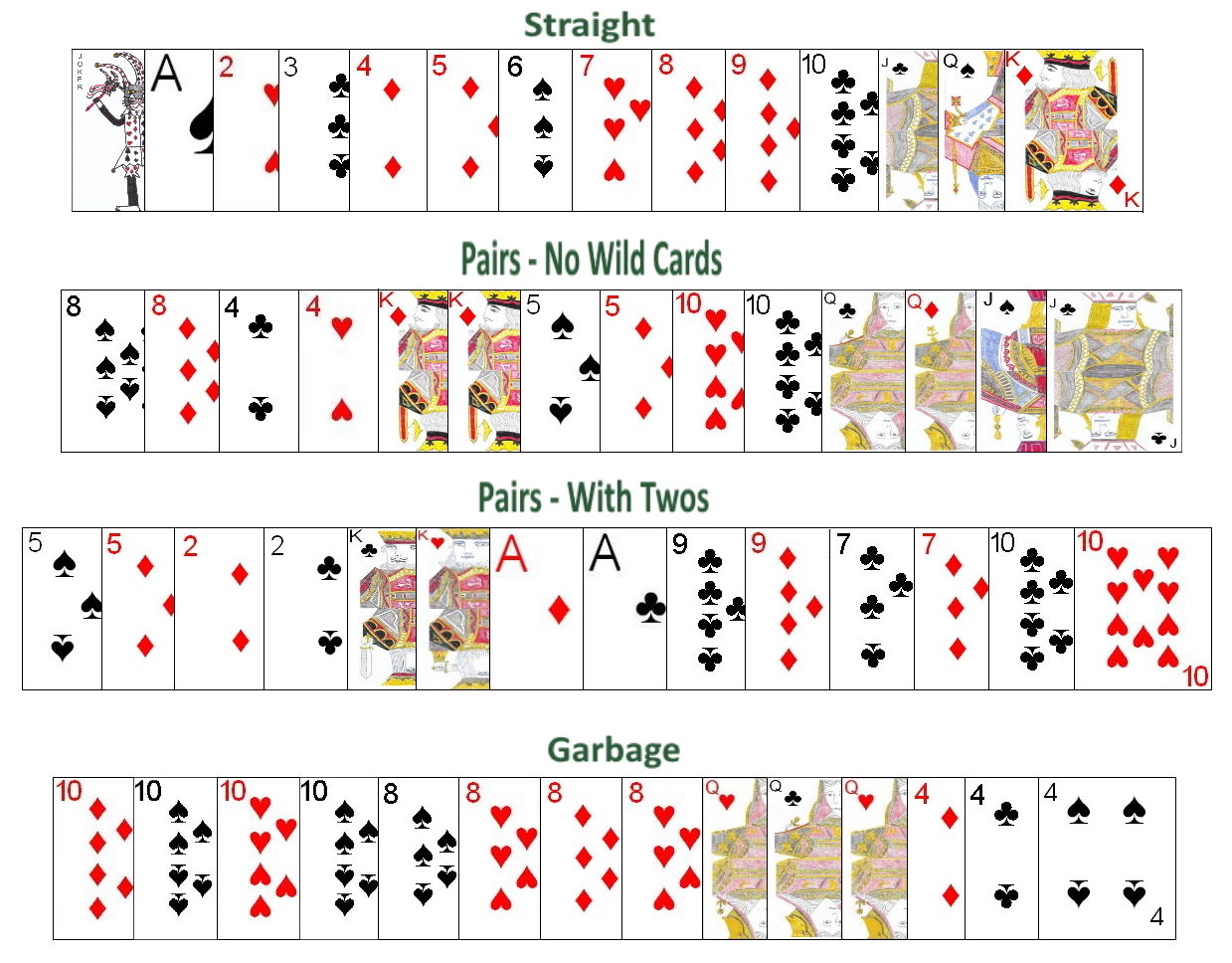
The second way a hand can end is if a player manages to form, in his hand, one of several special hands, after he draws from the stock. In this case, the player is not required to discard and simply shows his special hand, immediately ending that hand. However, a player may not thus play a special hand if either he or his partner have already made any melds during the current turn. The following are these special hands that can thus end the hand:
- Straight: This is a hand consisting of one card in every rank (Ace, 2, 3, 4, 5, 6, 7, 8, 9, 10, Jack, Queen, King, and one Joker). The cards need not be all of the same suit.
- Pairs - with no wild cards: This is a hand consisting of seven different pairs (two cards of the same rank). This hand may never contain any threes.
- Pairs - including twos: This is also a hand consisting of seven pairs, one of which is a pair of twos, another a pair of Aces, and another a pair of sevens. The remaining cards must be pairs of other denominations. This hand may never contain any threes.
- Garbage: This hand consists of two groups of four cards of the same denomination, and two groups of three cards of the same denomination. This combination may never contain any cards of denomination three.
The last way a hand can end is if the draw pile is exhausted, and a player is needing to draw from that pile and is unable to. This immediately ends the hand, and scoring for that hand then occurs. If the last card in the stock is a three, the hand also ends, withe player drawing that three adding it to his hand, and not permitted to meld it to the table.
Scoring: Once the hand ends, scoring for the hand then occurs. Scoring in Canasta Americana is rather elaborate, and there are several categories of scoring in the game, which will be detailed (with bonus or penalty points earned):
- Both teams score for every completed Canasta (meld of exactly seven cards) they have managed to complete during the hand. The following chart shows the scores for each Canasta type:
| Canasta Meld | Description | Bonus Scoring Value |
|---|
| Dirty | Canasta of rank Ace, 4, 5, 6, 8, 9, 10, Jack, Queen, or King which also contains one or two wild cards. | 300 |
| Pure | Canasta of rank 4, 5, 6, 8, 9, 10, Jack, Queen, or King which contains no wild cards | 500 |
| Pure Canasta (sevens or Aces) | Canasta in the rank of Ace or seven which contains no wild cards | 2500 |
| Wild Card - Twos | Canasta consisting completely of twos | 3000 |
| Joker Canasta | A Canasta consisting of exactly four Jokers and three twos | 2500 |
| Wild Card | Canasta consisting of Jokers (but less than four) and twos | 2000 |
- A team who manages to "go out" during the hand, scores a 100 point bonus.
- Penalties are applied to both teams for any incomplete Canastas melded
by that team. The following chart shows these penalty scores:
| Meld | Description | Bonus Scoring Value |
|---|
| Incomplete Ace Canasta | A pure Ace meld consisting of less than seven cards. | -2500 |
| Incomplete Seven Canasta | A meld of sevens consisting of less than seven cards | -2500 |
| Incomplete Joker meld | Wild card meld containing all four Jokers, but less than three twos | -2500 |
| Incomplete Wild Card meld | A completely wild card meld with less than seven total cards and not containing all four Jokers | -2000 |
- Penalties are also applied for players who have multiple (three or more) sevens or Aces remaining in the hand at the end of that hand. For a player having three or more Aces still remaining in the hand, his team has a -1500 point penalty assessed to his team. Similarly, for having three or more sevens remaining in the hand at the completion of the hand, his team is assessed a -1500 point penalty.
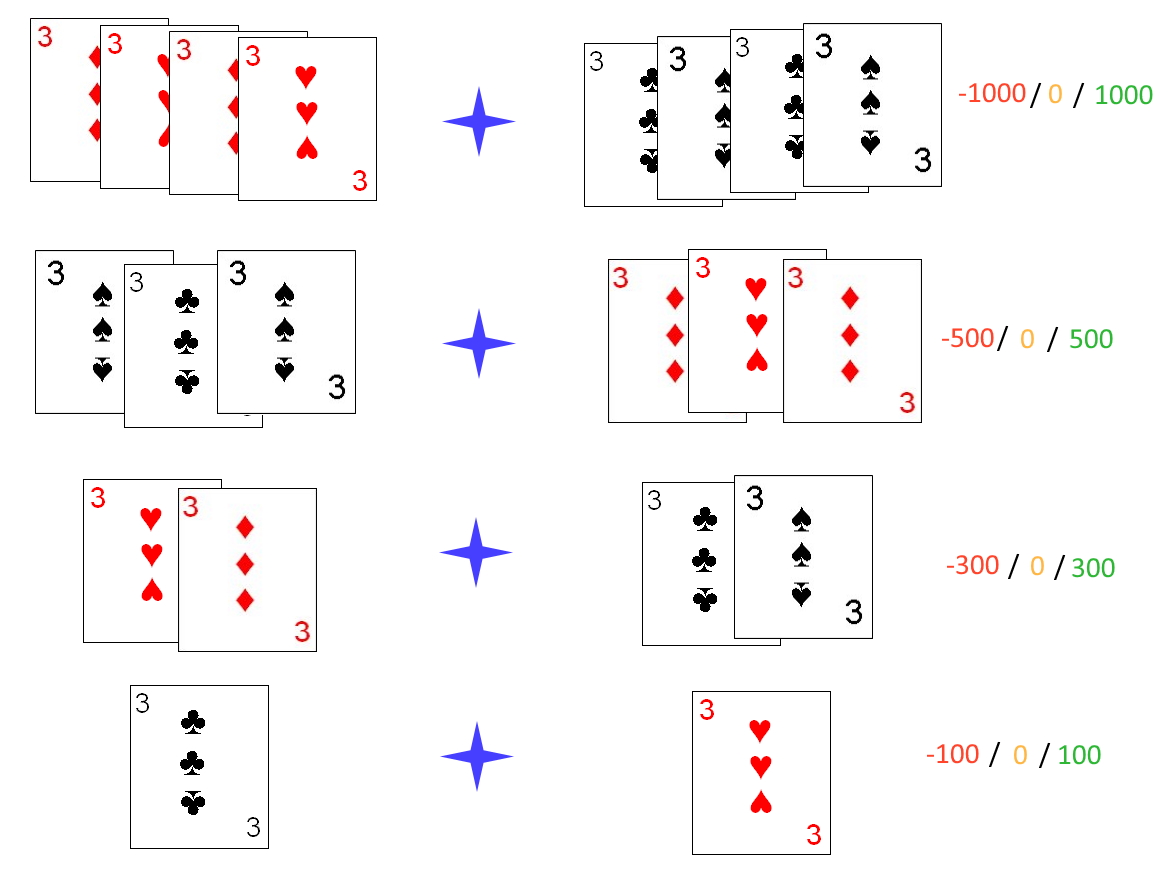
- Teams may also score for melded threes. If a team has melded no Canastas, however, these scores are a penalty, and thus subtracted from that teams overall score. If the team has melded exactly one Canasta during the hand, they neither earn a bonus or penalty for melded threes (earning
a net zero score for all such melded threes). If a team has melded two or more Canastas during the hand, scores for threes is a bonus, added to that teams cumulative score.
The penalties or bonuses thus earned by the team are as follows:
- For four threes, (all of the same color), the score is 1000 points.
- For three threes (all of the same color), the score is 500 points.
- For two threes (all of the same color), the score is 300 points.
- For one three of a particular color, this has a score of 100 points.
- For a team that has melded at least one Canasta, the total point value
of all cards melded to the table by that team (see the chart further above
showing the point value for each card in each meld), is added to that teams total score. This does not include the scores for threes.
- For a team that has not melded at least one Canasta, the total point
value of all cards melded by that team to the table is subtracted from that
teams ongoing score. However, since melded threes are already
subtracted from a team's score, as above, so they are not assessed an
additional penalty.
- For both teams, any cards remaining in the hand, have the scoring point value for that card subtracted from that teams overall score. In the rare event a team has any three remaining in the hand, that card
thus has a scoring penalty value of -5 points.
- If a team manages to play one of the "special hands" as described above, that team scores for this special hand as follows:
| Special Hand | Bonus Scoring Values |
|---|
| Straight | 3000 |
| Pairs - with no wild cards | 2500 |
| Pairs - including twos | 2000 |
| Garbage | 2000 |
If a team wins the hand by playing one of these special hands, that team scores the designated score from the chart, but no other scores or penalties are scored on that same hand.
If, at the end of any hand, after the scoring for that hand has been completed, either or both teams have an accumulated score of 8500 or more, the team with the highest total score is declared the winning team.
Joker Canasta: Joker Canasta is a variation on the base game which includes a number of derivations from the standard game. Joker Canasta is thus played identically to the standard game as described above, with the following differences:
- At the start of each hand, the players are each dealt a hand of 13 total cards.
- In order for one of the teams to go out, that team must have melded a minimum of two Canastas
on that hand amongst the two players on that team.
- Any Canasta can never contain more than seven total cards. If the players want to meld additional cards of that rank, they must create a new meld of that particular denomination.
- The initial melding requirement for a team is somewhat different than that as per the original game. The following chart shows these initial melding requirements for the teams, based on that team's current score in that hand:
| Current score for Partnership | Initial Meld Requirement |
|---|
| Under 3000 | 95 |
| 3000 to 4999 | 125 |
| 5000 or more | 155 |
- The first team to reach or exceed 8500 cumulative points at the end of a hand is declared the game winning partnership.
- The discard pile is always considered frozen to both teams, and thus can only be taken by a player with two natural cards as the same denomination as the top card in the discard pile, which are then immediately played as part of a legal meld.
- Canastas consisting of solely wild cards are allowed. Such a Canasta is
worth 2000 bonus points at the end of the game, unless that Canasta contains
all four Jokers in which it scores 3000, or 4000 if the wild card Canasta
consists of all twos.
- In Joker Canasta, both red threes and black threes have a bonus value. The first three of a specific color (either red or black) played by a partnership earns that team 100 points, with the second and third three of that same color earning that team 200 points, and if that side manages to play the fourth three of that color, that team earns 500 points for that fourth card. These cards should be played immediately face-up to the table when received. The scores are positive for a team which has melded at least one Canasta during the hand, but are subtracted from the score of a team if they have not managed to meld at least one Canasta on the hand.
In all other aspects Joker Canasta is played identically to standard Canasta as described above.
Copyright © 2015 CatsAtCards.com. All rights reserved.
 Canasta, originating as a Latin American game quickly spread to the United States and much of the rest of the world. It was the most popular of all card games in the United States in the early 1950's and is still popular in many parts of the world today.
This rummy type game which is named for the Spanish word for basket, is also the name for one the special melds required in the game.
Canasta, originating as a Latin American game quickly spread to the United States and much of the rest of the world. It was the most popular of all card games in the United States in the early 1950's and is still popular in many parts of the world today.
This rummy type game which is named for the Spanish word for basket, is also the name for one the special melds required in the game.
 All jokers and twos (deuces) are wild cards, and can thus be melded (see below) with other, natural cards at which point the wild card takes on the rank of the natural cards used in the meld. Wild cards must always be melded with natural cards, in other words a meld of just wild cards is never allowed. For scoring of the meld, however, the wild cards earn a score of 50 or 20, as per the chart below.
All jokers and twos (deuces) are wild cards, and can thus be melded (see below) with other, natural cards at which point the wild card takes on the rank of the natural cards used in the meld. Wild cards must always be melded with natural cards, in other words a meld of just wild cards is never allowed. For scoring of the meld, however, the wild cards earn a score of 50 or 20, as per the chart below. If a player is dealt a red three as part of his initial hand, at his first turn, he immediately lays it face up in front of himself and draws a replacement card from the stock. If anytime during the play of his hand, he draws a red three from the stock, he also lays it face up in front of himself also drawing a replacement from the stock. If he obtains a red three from taking the discard pile, however, he still lays it face-up in front of himself, but does not draw a replacement card. At the end of the hand, these red threes can produce significant bonus points for the holder (although, in some cases they can also incur a penalty, as explained in the scoring section below).
If a player is dealt a red three as part of his initial hand, at his first turn, he immediately lays it face up in front of himself and draws a replacement card from the stock. If anytime during the play of his hand, he draws a red three from the stock, he also lays it face up in front of himself also drawing a replacement from the stock. If he obtains a red three from taking the discard pile, however, he still lays it face-up in front of himself, but does not draw a replacement card. At the end of the hand, these red threes can produce significant bonus points for the holder (although, in some cases they can also incur a penalty, as explained in the scoring section below).
 A natural canasta (sometimes called a pure canasta) is when there are no wild cards in the Canasta, thus all seven cards are of the exact same rank. A mixed canasta is when the meld contains one or more wild cards.
After a canasta is first melded, additional cards may be added to the meld. However, if any wild cards (never more than three) are added to an existing canasta that canasta then becomes a mixed canasta (which reduces its bonus score added at the end of the hand).
In addition, a partnership MUST meld at least one canasta (either natural or mixed) before it can go out. Until the partnership has melded a canasta, both players must retain at least one card in their hand. The bonus score, awarded at the end of the hand, is 500 for each natural canasta melded and 300 for each mixed canasta.
A natural canasta (sometimes called a pure canasta) is when there are no wild cards in the Canasta, thus all seven cards are of the exact same rank. A mixed canasta is when the meld contains one or more wild cards.
After a canasta is first melded, additional cards may be added to the meld. However, if any wild cards (never more than three) are added to an existing canasta that canasta then becomes a mixed canasta (which reduces its bonus score added at the end of the hand).
In addition, a partnership MUST meld at least one canasta (either natural or mixed) before it can go out. Until the partnership has melded a canasta, both players must retain at least one card in their hand. The bonus score, awarded at the end of the hand, is 500 for each natural canasta melded and 300 for each mixed canasta.


 Sequence Melds:
As in standard Canasta, players can meld groups of cards of the same rank (with any appropriate wild cards), but, in this game sequences can also be melded. A sequence consists of three or more cards, of the same suit that are numerically in sequence (such as 8,9 and 10 of spades). The Ace is considered high and thus comes after the king.
Sequence Melds:
As in standard Canasta, players can meld groups of cards of the same rank (with any appropriate wild cards), but, in this game sequences can also be melded. A sequence consists of three or more cards, of the same suit that are numerically in sequence (such as 8,9 and 10 of spades). The Ace is considered high and thus comes after the king.




 The game consists of a number of meld types, as follows:
The game consists of a number of meld types, as follows:
 The second way a hand can end is if a player manages to form, in his hand, one of several special hands, after he draws from the stock. In this case, the player is not required to discard and simply shows his special hand, immediately ending that hand. However, a player may not thus play a special hand if either he or his partner have already made any melds during the current turn. The following are these special hands that can thus end the hand:
The second way a hand can end is if a player manages to form, in his hand, one of several special hands, after he draws from the stock. In this case, the player is not required to discard and simply shows his special hand, immediately ending that hand. However, a player may not thus play a special hand if either he or his partner have already made any melds during the current turn. The following are these special hands that can thus end the hand:

